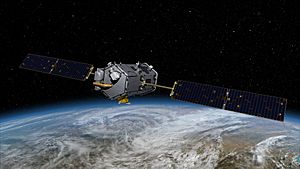Orbiting Carbon Observatory facts for kids

Artist rendition of the OCO satellite as it would look in orbit
|
|
| Mission type | Climatology |
|---|---|
| Operator | NASA |
| Mission duration | Launch failure Planned: 2 years |
| Spacecraft properties | |
| Bus | LEOStar-2 |
| Manufacturer | Orbital Sciences |
| Launch mass | 530 kg (1,170 lb) |
| Payload mass | 150 kg (330 lb) |
| Dimensions | Stowed: 2.3 × 1.4 m (7.5 × 4.6 ft) |
| Power | 786 W |
| Start of mission | |
| Launch date | 24 February 2009, 09:55:31 UTC |
| Rocket | Taurus-XL 3110 |
| Launch site | Vandenberg LC-576E |
| Contractor | Orbital |
| Orbital parameters | |
| Reference system | Geocentric |
| Regime | Sun-synchronous |
 |
|
The Orbiting Carbon Observatory (OCO) was a special NASA satellite. Its main job was to study carbon dioxide (CO2) in Earth's atmosphere from space. Scientists wanted to see how much CO2 was in the air all over the world. This information helps us understand our planet's climate better.
Sadly, the OCO satellite was lost during its launch on February 24, 2009. The rocket carrying it, a Taurus rocket, had a problem. A part called the "payload fairing" (which is like a protective nose cone) did not come off. Because of this extra weight, the satellite could not go fast enough or high enough into space. It then fell back to Earth and crashed into the Indian Ocean near Antarctica.
Contents
What was the Orbiting Carbon Observatory?
The Orbiting Carbon Observatory, or OCO, was a satellite built by NASA. Its main goal was to make very precise measurements of carbon dioxide (CO2) in our planet's air. Carbon dioxide is a gas that plays a big role in Earth's climate.
Why was OCO important?
Scientists wanted OCO to help them understand the "carbon cycle." This is how carbon moves around Earth, from the air to plants, oceans, and soil. By measuring CO2 from space, OCO would have shown where carbon dioxide was being released and where it was being absorbed. This data is super important for studying climate change and how our planet is changing.
The Launch and What Went Wrong
OCO was launched on February 24, 2009, from Vandenberg Air Force Base in California. It was carried by a Taurus-XL rocket. Everything seemed normal at first. However, about three minutes into the flight, a critical part of the rocket failed.
What is a Payload Fairing?
A "payload fairing" is like a protective shell or nose cone at the top of a rocket. It keeps the satellite safe during the powerful launch through Earth's atmosphere. Once the rocket is high enough, this fairing is supposed to split open and fall away. This allows the satellite to be released into space. For OCO's launch, the fairing did not separate. The rocket was still carrying this heavy shell. This made the rocket too heavy to reach the correct speed and height needed to put the satellite into orbit. Because of this, OCO fell back to Earth.
Images for kids



